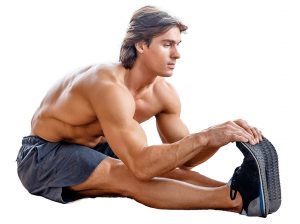
Warm-up before training at the gym – examples of exercises and warm-up time
 Warm-up before training at the gym – examples of exercises and warm-up time
Warm-up before training at the gym – examples of exercises and warm-up time
Warm-up before training is our duty. Without it, we risk injuries. Sometimes we complain of a back injury; other times, we suffer from knee or shoulder pain. Many times this is the result of a neglected warm-up. We will check how important it is and how to perform a proper warm-up.
Why is the warm-up before the workout so important?
Our team at cross the limits shop vitamins and supplements UK always refer to “warm-up before training is our duty if we do not want to expose ourselves to injury”. Remember that an injury often results from unnatural movement with load, for which the joints, muscles, or ligaments were not prepared. The warm-up prepares our body for the effort to which it is subjected during exercise at the gym. However, the warm-up preceding the workout also has other advantages. The goals of an excellent warm-up include:
– Increase body temperature – a warm-up raises body temperature to 37-39 degrees C and speeds up blood circulation. This translates into more flexible muscles that are more susceptible to stretching.
– Joint protection – more synovial fluid is produced during the warm-up. It minimizes surface friction, which promotes joint protection.
– Stimulation of the central nervous system – stimulation of the CNS promotes a state of optimal mobility.
– Reduce the risk of injury – a warm-up before training minimizes the risk of injury. Muscles, joints, tendons, and ligaments are more flexible after the introduction.

How long should the warm-up last before strength training?
We already know the importance of warm-up for our health. However, we should remember that it is only a preparation of the body for the physical effort that awaits us during the target training being our priority.
We can adjust the warm-up time to our own needs, although it is assumed that it should not last less than 10 minutes. The optimal warm-up time before training is 15 minutes. However, a general rule should be followed here. It says that you should be slightly sweaty at the end of the warm-up and have an elevated pulse rate.
How to perform a proper warm-up step by step?
Now that we know the importance of the warm-up, we should treat it as an obligatory part of the workout. Within 10-15 minutes, we can perform several exercises that will allow us to increase our heart rate and warm up our joints and soft tissues.
 Cardio exercises before training – do they make sense?
Cardio exercises before training – do they make sense?
Among bodybuilding or fitness enthusiasts, cardio exercises are performed after strength training. However, a short cardio session can also be performed as a warm-up. For sure, this way, we can quickly raise our body temperature and pulse rate.
An example of a warm-up in a mini cardio session is running on a treadmill for several minutes. If we do not exercise at the gym but in the comfort of our own home, we often invest in a cross-trainer or electric bike. These pieces of equipment are also suitable for a short cardio session before training. Especially good is a cross-trainer involving lower and upper limbs.
Our heart rate should oscillate within 65-70% of the maximum pulse frequency during such a session. We can calculate it with the following formula:
x = 220 – age

Rolling as a part of the warm-up. Why is it worth it?
Rolling increases blood circulation in the skin and muscles; it also allows for relaxing overactive muscles and increasing the joints’ range of motion. Finally, it increases the flexibility of all soft tissues, except powers, affecting fascia and ligaments.
Just remember that just like too much cardio exercise, excessive rolling can also harm us. We should be careful not to roll a weak muscle for too long, which will weaken it. If you are already using a roller before training, spend no more than a few minutes rolling. It is more important to do it after a workout as a part of biological regeneration.
Dynamic stretching
Before strength training, but of course, not only should we also stretch well. However, we are not talking about traditional stretching here. Let’s take care of dynamic stretching, i.e., performing basic joint movements (e.g., bending, straightening, inversion, adduction, twists, rotations) at a fast pace.
Muscle activation
After the dynamic stretching, let’s take care of the muscles that will be most engaged during the strength training. Let’s focus here on the muscles that serve as stabilizers.
Before the strength training, we can use our own body weight at this stage of the warm-up. Specialized but inexpensive equipment such as elastic bands or tapes will also be helpful. Remember not to overdo the muscle activation and not to tire them. Therefore, do not focus on a single part and devote up to several minutes per session.
Initial series
 At the beginning of training, we should perform preliminary series. We can use the so-called Helms protocol here. If we use this solution, in the first series, we perform 5 repetitions with half of the load assumed during the main series.
At the beginning of training, we should perform preliminary series. We can use the so-called Helms protocol here. If we use this solution, in the first series, we perform 5 repetitions with half of the load assumed during the main series.
The second series consists of 3 repetitions with 70 percent of the weight declared for the main series; in turn, only 1 repetition with 90 percent of such importance in the third series. This way, we warm up the muscles and at the same time improve the movement pattern.
There is no doubt that the warm-up is significant before strength training. Like all other exercises, it is our duty. It is an essential element for beginners and advanced athletes. Unfortunately, we often treat it marginally, and we do not know how to perform a proper warm-up.
Meanwhile, it is an element of training, which prepares us for the appropriate training. In this way, we will increase the range of motion in our joints, we will also achieve better effects during exercise, and most of all, we will minimize the risk of injury.
If you have no idea how to perform a proper warm-up before the workout, you can start with a short cardio session. Then we should move on to dynamic stretching, rolling, and muscle activation, including the initial series.
Take care of proper hydration already during the workout. Water is an excellent choice to prevent dehydration. Additional supplements will also work well. The best option is carbohydrate supplements which can be taken during and after training. This will increase the glucose level in muscle cells and provide you with an additional energy source.


